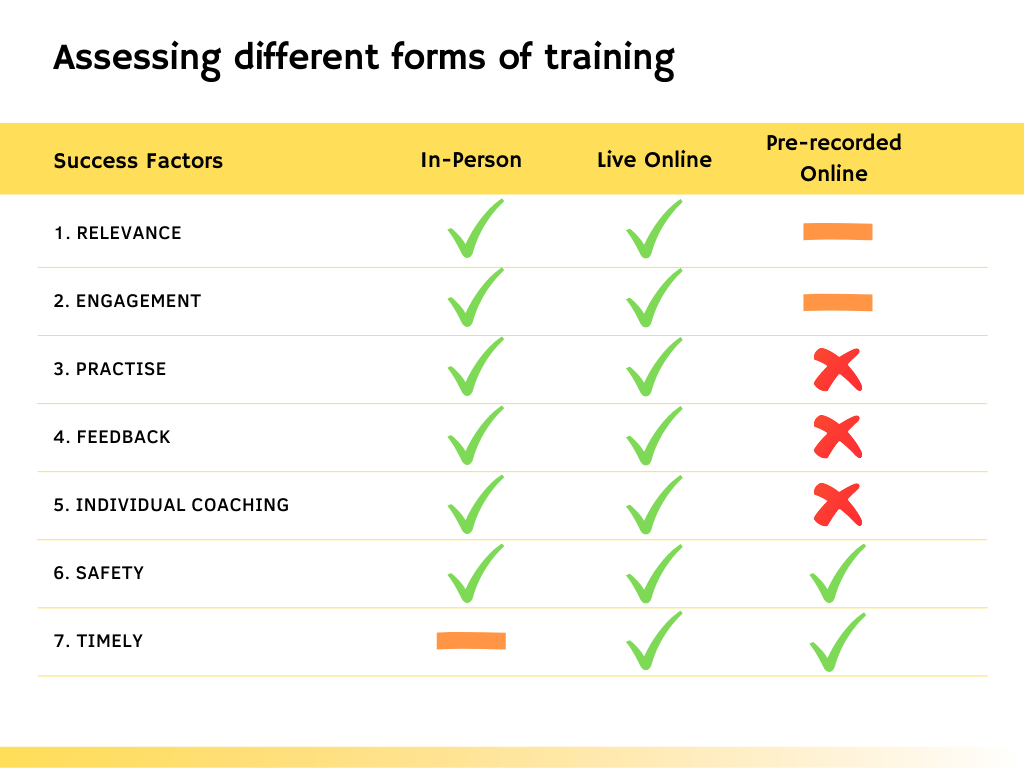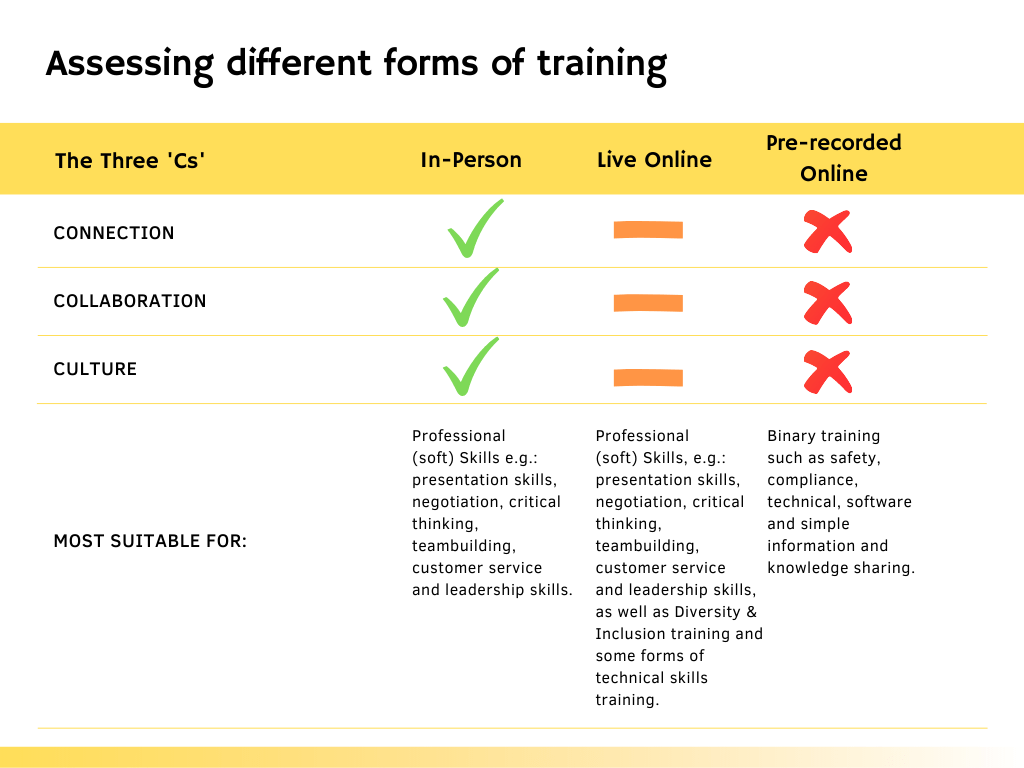In this Article...quick links

But before we do, let’s step back and briefly remind ourselves of the key factors that contribute to creating a successful learning program – a program that delivers meaningful professional development outcomes.
In our view, the 7 success factors are-
1. Relevance
Making sure the training content is immediately relevant to the participants of the training – to them and to their current/future roles. For this to be the case, we’d argue strongly that the content should also be capable of flexing around each employee’s individual development goals.
2. Engagement
For employees to get the most out of the learning opportunity, it needs to be engaging. Making it relevant will go part way to achieving this. But even relevant content can be delivered in a boring way, and so switch people off. Ensuring a training program is engaging can be done in many ways. It could be by making it interactive, thought-provoking, inspiring, or fun, or collaborative. We’d argue a combination of all of these is ideal!
3. Practice
You can attend a training session that includes highly relevant content, and is hugely engaging, but unless you put the learning into practice, in a role-relevant way, what’s the point? Imagine you’re learning to play tennis. Knowing WHAT to do, in theory, is only the beginning. Understating HOW to do it, on the court with a racket in your hand, is what really matters. Professional training is no different.
4. Feedback
Along with practice, expert feedback is critical. This is especially true when the aim of the training is behavioural change. Feedback highlights those areas where people can improve and ensures they continue to do what’s working well.
5. Individual Coaching
Practise and feedback (P-F) are, we believe, essential components for most forms of training. Coaching (C) though is the third part of the dynamic. Individual coaching truly catapults people’s learning success. Without it, people’s learning progress will not only be slower, but it will also be more limited.
6. Safety
In order to make the most of the PFC (Practice-Feedback-Coaching) dynamic, the learning environment needs to feel safe and supportive. Only by ensuring this will people be comfortable to explore and experiment with new ideas, skills and techniques.
7. Timely
You can have all of the above ingredients but if the training is taking place at the wrong time (people don’t need the training yet), or a bad time (people don’t have the bandwidth to absorb the training), the training investment is likely to be wasted.
These 7 success factors are fundamental in successful learning. Now comes the question of the delivery method. Is it better to do in-person or online training? We take a look at the advantages and disadvantages of both through the lens of the 70:20:10 framework. In this instance, we are focusing on the ’10’ i.e. formal learning situations.
Advantages of in-person training
There’s no doubt that, when done well, in-person training delivers against each of the 7 success factors just highlighted
There are three additional, and significant, benefits of running training in-person. These benefits fall under the headings of the 3Cs: Connection, Collaboration, and Culture.
Connection
Put simply, when people are in the same physical space together, working on the same thing, they build a connection. The learning occasion becomes a shared experience. And because humans are instinctively social, a physically shared and social experience is more likely to be enjoyed by the participants, and so become emotionally imprinted. As Maya Angelou said ‘People won’t remember what you said or did, they will remember how you made them feel.’
Not only that, but in-person training creates a safe space for networking. Networking helps employees understand and appreciate the roles of others, it can break down barriers caused by silos, and it can open doors to otherwise unknown opportunities.
Collaboration
From connection comes collaboration. In-person workshops are usually run over a day or multiple days. This timing allows the facilitator to flex time throughout the training to allow participants to discuss and debate different ideas. This process drives engagement and helps embed learning. It also allows time for employees to share their own experiences – the challenges they’ve faced and the solutions they’ve found that have worked for them. This form of collaboration – the sharing of experience and knowledge, often from more senior or experienced people in the group, is priceless. Naturally, in-person group workshops also enable teamwork – and teamwork can be a powerful catalyst for shared discovery, problem-solving, and learning.
Culture
All these things – creating connections and fostering collaboration, ladder up to support an organisation’s culture and values. In today’s flexible, dispersed world of work, reinforcing an organisation’s culture has never been more important, and yet it’s never been harder to do. In-person training can be a small, but important, enabler of this.
In-person training naturally promotes meaningful connections, facilitates group collaboration, and supports organisational culture These are, we believe, incredibly valuable supplementary outcomes – in addition to the core learning outcomes the training is specifically designed to achieve. Conversely, online training rarely, if ever, has the flexibility of time or space, to foster these important activities.
In our view, Professional (soft) Skills training, such as business presentation skills training (which is our area of expertise), is most effective and successful when delivered in-person, and in small groups. Other Professional Skills training that we believe benefits from being delivered in-person includes negotiation, critical thinking, teambuilding, customer service and leadership skills.
Disadvantages of in-person training
The most obvious disadvantage of in-person training vs online training, albeit this doesn’t have any effect on training outcomes directly, can be participant travel costs. Plus, if the distances are substantial, possible overnight accommodation costs. These can be significant.
The other consideration is time. Typically the shortest in-person workshop is 2-3 hours, whereas you can find online ‘courses’ that last just 5 minutes.
And finally, there’s the space required for hosting an in-person workshop (in-house, or at an external venue – which would incur additional cost), which is clearly not a factor for online training.
Now let’s look at the advantages of online training. When we look at online training it’s important to distinguish between live online training and pre-recorded online training.
Advantages of live online training
For many clients, the main advantage of live online training (and for that matter, pre-recorded training content) is that there aren’t any travel costs to bring people together.
There can also be greater flexibility in terms of participant numbers as, in theory, any number of people can jump onto a VC platform to attend the training. This in turn can, though not always, reduce the per-participant training cost.
In terms of success factors highlighted earlier, live online training can be relevant and engaging. It’s also possible to include practice, feedback and coaching time (as all our live online business presentation skills training programs do). They can create a safe learning environment and be delivered in a timely way. A word about timing – in our view 1-hour modules are ideal. Occasionally a couple of modules can be run concurrently providing there are breaks throughout and, importantly, the modules incorporate plenty of kinaesthetic or interactive/practical learning opportunities.
Live online training programs, when carefully created and skilfully facilitated, can be highly effective for delivering Professional (soft) Skills training. They can also be ideal for diversity & inclusion training and some forms of technical skills training.
 Disadvantages of live online training
Disadvantages of live online training
Whilst live online training can be an attractive option, it’s crucial to acknowledge that the success factors we’ve identified are only possible when the training is delivered in small groups. In our experience, 8 participants is the absolute maximum. The larger the group, the less relevant the training will be. That’s because the larger the group, the more varied the learning needs will be. As a facilitator it becomes impossible to flex the content to meet everyone’s needs, all of the time. Hence overall content relevancy decreases. This in turn, of course, significantly drags down people’s engagement. Furthermore, the larger the group, the less time there is for individual practice, feedback and coaching. Without these elements, particularly for training that involves behavioural change, learning outcomes will be substantially compromised.
When it comes to the 3Cs: Connection; Collaboration; Culture – as we’ve already mentioned, it’s extremely difficult for the participants to create emotional connections, for the facilitator to incorporate meaningful group collaboration, and for the training to support organisational culture, when the training is delivered live online.
Advantages of pre-recorded online training
The key advantage of pre-recorded online training is that you can view it anytime, anywhere. It’s Training-On-Demand. So from a timing perspective, it’s completely flexible.
Also, because the training is pre-recorded, there’s no interaction. This means that the content can be delivered in less time. It’s not uncommon to see bite-sized training programs that last just 5 minutes.
Pre-recorded online training is well suited for ‘binary’ training content e.g. training that involves right/wrong answers or ways of doing things. Safety, compliance and technical/digital training are good examples of binary training. Pre-recorded online training is also suitable for simple information/knowledge-sharing sessions.
 Disadvantages of pre-recorded online training
Disadvantages of pre-recorded online training
There are many drawbacks to pre-recorded online training. We call it ‘lonely-learning’ because by and large people watch the content on their own. Not only is it lonely, but there’s no scope for the Practise-Feedback-Coaching loop, which can be critical for some forms of training – especially Professional Skills training such as business presentation skills.
Also, because it’s pre-recorded, it can’t be tailored for those that are watching it. As a result, much of it may not be that relevant. This, combined with the fact it’s ‘lonely-learning’, means it may not be engaging. And if it’s not engaging, the learning won’t be as transformational, or embedded.
Finally, pre-recorded online training isn’t able to contribute to the 3Cs – enhance employee connection, engender group collaboration or support organisational culture.
One way of overcoming the disadvantages associated with almost all online training is to blend it with in-person training, coaching or mentoring. This combination can be very powerful and suitable for almost all types of training.
Assessing different forms of training
When deciding what form of training to select, the starting point must always be to conduct a thorough training needs analysis (TNA), either via performance reviews or career conversations. Simply giving employees access to 10,000+ online courses doesn’t mean they’ll develop the skills the business requires. Only once the requirements of the business have been understood and consequently the learning needs of its people (the gap), should the form of delivery that would be the most suitable start to be considered. And remember, any training solution should be assessed against the 7 success factors:
- Relevance
- Engagement
- Practise
- Feedback
- Individual Coaching
- Safety
- Timely
After this, the importance of the 3Cs (Connection, Collaboration and Culture) to your employees and to your organisation needs to be considered.
We hope the two tables below, summarising how success factors and the three ‘Cs’ apply to different forms of training, will help you to assess the advantages and disadvantages of different types of training so that you can select the best delivery format for your people.
Improve your people’s presentation success through our range of in-person, online and blended training and coaching programs.
For nearly 20 years we have been the Business Presentation Skills Experts, training & coaching thousands of people in an A-Z of global blue-chip organisations – check out what they say about our programs.
To find out more, click on one of the buttons below:

Belinda is the Co-Founder and Managing Director of SecondNature International. With a determination to drive a paradigm shift in the delivery of presentation skills training both In-Person and Online, she is a strong advocate of a more personal and sustainable presentation skills training methodology.
Belinda believes that people don’t have to change who they are to be the presenter they want to be. So she developed a coaching approach that harnesses people’s unique personality to build their own authentic presentation style and personal brand.
She has helped to transform the presentation skills of people around the world in an A-Z of organisations including Amazon, BBC, Brother, BT, CocaCola, DHL, EE, ESRI, IpsosMORI, Heineken, MARS Inc., Moody’s, Moonpig, Nationwide, Pfizer, Publicis Groupe, Roche, Savills, Triumph and Walmart – to name just a few.



 Disadvantages of live online training
Disadvantages of live online training Disadvantages of pre-recorded online training
Disadvantages of pre-recorded online training
